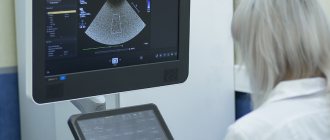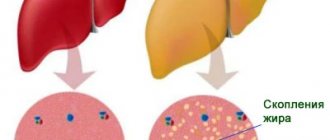A hepatologist is a doctor whose professional activity is aimed at diagnosing and treating liver diseases. Hepatology is a branch of gastroenterology that focuses on problems of the liver, gallbladder and biliary tract. A separate field of medicine is pediatric hepatology, which takes into account the structure of the liver, its development and the characteristics of pathology in the child’s body.
Professional tasks
In order to work as a hepatologist, you need to obtain a diploma of higher medical education, after which you must complete an internship in the gastroenterology department under the guidance of a qualified experienced doctor. During training you need to perfectly master the following sections:
- anatomy and physiology of the hepatobiliary apparatus;
- pathological physiology of this system;
- age-related features of functioning in patients of different categories;
- specific diagnostic methods;
- therapy and prevention of liver and gallbladder diseases.
One of the most important areas remains preventive activity, which is necessary even after successful treatment and can save the patient from repeated serious dysfunctions. The hepatologist can adjust the daily routine and food intake in such a way that the need for therapy disappears or is postponed for a significant period.
In addition, this specialist, as a rule, is simultaneously engaged in scientific and research activities aimed at finding new and alternative methods for recognizing pathologies and neoplasms, as well as preventing their development.
Another area of activity of a hepatologist is the search for optimal and effective medications that can quickly and without side effects help patients with damage to the hepatobiliary system. In addition, this doctor can determine the need for consultation with related specialists, to whom he will refer the patient for consultation, if necessary.
Chronic liver diseases - “the second epidemic of our century”
Liver diseases are one of the first places in terms of prevalence and are currently the fifth most common cause of death in many developed countries. The increase in the incidence of chronic liver diseases is called the “second epidemic of our century” after the “epidemic” of cardiovascular pathology.
Chronic liver diseases have a progressive course. Regardless of the cause of liver disease, there are two main stages in its development: the stage of chronic hepatitis and the stage of liver cirrhosis. At the stage of liver cirrhosis, life-threatening complications such as liver failure and internal bleeding develop. The presence of liver cirrhosis predisposes to the development of primary liver cancer.
Among a number of causes of chronic liver diseases, the most common are: 1) hepatitis B and C viruses, 2) alcohol abuse, 3) lipid metabolism disorders and diabetes mellitus, leading to the development of so-called non-alcoholic fatty hepatitis. Often these factors are present in the same patient, which accelerates the progression of the disease.
Due to the uncontrolled use of various medications, the development of dosage forms for chronic liver diseases has become more frequent. Other liver lesions (autoimmune, genetically determined) are much less common. Why is the incidence of chronic liver disease increasing?
The increase in the incidence of chronic liver diseases is associated with an increase in infection of the population with hepatitis B and C viruses (especially in the last decades of the 20th century), an increase in alcohol consumption, as well as an “epidemic” of obesity observed throughout the world.
Over the past two decades, extensive measures have been taken to prevent infection with hepatitis B and C viruses. First of all, this is mandatory vaccination against hepatitis B for all newborns and adolescents, as well as persons at risk of infection (family members and sexual partners of those infected with hepatitis B virus, medical workers, etc.), testing of donor blood using highly sensitive methods , the use of disposable needles and syringes, effective methods for sterilizing medical instruments. An important point is mandatory testing to identify markers of hepatitis B and C viruses for all patients hospitalized for treatment in hospitals, as well as patients undergoing various surgical operations and endoscopic research methods (gastroscopy, colonoscopy, etc.) in a clinic. .
All this made it possible to reduce the incidence of acute hepatitis, but did not eliminate it completely. The reasons for the persistence of high incidence are the widespread prevalence of drug addiction, the use of non-sterile instruments when performing various non-medical manipulations that damage the skin (piercing, tattoos, manicure/pedicure), refusal of preventive vaccination against hepatitis B, and “unprotected” sex.
While the incidence of acute viral hepatitis is decreasing, the number of patients with chronic viral hepatitis and liver cirrhosis is growing incredibly quickly. This is due to the peak of drug addiction in the 90s, the lack of testing of donor blood for the hepatitis C virus until 1990, since this virus was first identified only in 1989. Since liver cirrhosis develops on average 20-30 years after infection with hepatitis viruses, there is now a peak in detection of infection at the stage of liver cirrhosis. Why are chronic liver diseases detected late - at the stage of liver cirrhosis?
The course of chronic viral hepatitis, like all chronic liver diseases, is characterized by a long absence of symptoms of the disease. For many years, the patient may feel completely healthy, or may only notice increased fatigue. The “silence” of the liver is due to the fact that its tissue does not have nerve endings. Pain in the right hypochondrium, where the liver is located, is rarely observed in chronic hepatitis and cirrhosis of the liver and can be caused by concomitant damage to the gallbladder, or the duodenum or colon located close to it. The second reason for the “silence” of the liver is the significant compensatory capabilities of this unique organ. Hepatic manifestations of the disease, such as jaundice, itching, enlargement of the liver and spleen, as a rule, appear only at the stage of severe liver cirrhosis. Long-term absence of liver symptoms is the main reason for late detection of liver disease.
The liver is a unique organ that performs the most important functions in the human body. It is the main laboratory of the body, in which millions of chemical reactions occur per minute. Liver diseases affect the condition of other organs - the entire body as a whole. Therefore, in the absence of liver symptoms, so-called “non-hepatic” manifestations are often observed, which hepatologists call “masks” of liver disease. “Non-hepatic” manifestations, in addition to malaise and weakness, include joint and muscle pain, various skin manifestations (rashes, hemorrhages on the skin), changes in peripheral blood (anemia and others), signs of kidney damage (changes in urine tests), endocrine disorders. Because of this, patients with chronic hepatitis or cirrhosis of the liver often turn to doctors of various other specialties - rheumatologists, dermatologists, hematologists, endocrinologists, nephrologists. “Masks” can distract the attention of the patient and doctors from the condition of the liver for a long time and cause late recognition of the severity of its disease.
In the vast majority of cases, chronic hepatitis or cirrhosis of the liver is detected during “random” examinations (before surgery, during medical examination, etc.) in patients who did not even suspect they had liver disease. The currently recorded incidence of chronic diseases is only the tip of a huge iceberg, that is, it is significantly lower than the true prevalence of liver pathology. Who needs to see a hepatologist? — Anyone who has been found to be a carrier of the hepatitis “B” or “C” viruses — Anyone who has had an enlarged liver — Anyone who has detected abnormalities in liver parameters in a biochemical blood test — All people who regularly drink alcohol — All patients who have had long-term suffer from obesity, diabetes mellitus - All patients who exhibit unmotivated weakness, malaise, pain in the joints, muscles, skin rashes like vasculitis, abnormalities in blood tests and the diagnosis of the disease in which remains unclear.
Why is it advisable for everyone applying to a medical institution to be tested for carriage of the hepatitis B and C viruses?
The increasingly frequent accidental detection of viral liver diseases in medical practice, including at the stage of liver cirrhosis, indicates the insufficiency of the legally approved mandatory examination for carriage of hepatitis viruses only in certain groups of people. These groups include patients hospitalized in a hospital, patients before surgery and endoscopic examinations, as well as pregnant women and people at risk of infection.
Examination for the presence of carriage of the hepatitis B and C viruses of all persons applying to medical institutions will make it possible to diagnose the disease at an earlier stage, before the viral infection leads to irreversible changes - the development of cirrhosis of the liver and its complications, to liver cancer.
It is especially important to screen young patients for carriage, as they are the most active sources of infection through sexual contact. It is important to examine women of childbearing age not so much during pregnancy as at the planning stage. This will allow treatment before pregnancy and reduce the incidence of infection among newborns. In young people, the effectiveness of antiviral treatment is highest.
It is important to know that the successes of the last decade in the treatment of chronic viral hepatitis are enormous. Chronic hepatitis C is classified as a completely curable disease. For the treatment of chronic hepatitis B, there are drugs that can control the disease - prevent the development of cirrhosis and primary liver cancer. Early detection of infection is the main path to successful treatment and prevention
spread of hepatitis viruses!
Narrow focus
In addition to the general direction, there are also narrow directions of hepatologists. This is due to the fact that the work and anatomical features of the liver and gall bladder differ significantly in different age categories. In addition, for various types of pathologies and medical care, this doctor must have certain skills acquired during postgraduate education.
This contributed to the identification of such narrow areas:
- Pediatric hepatologist (deals with children under 14 years old). Ideally oriented in the anatomy and age-related characteristics of the liver and bile ducts. Most often, congenital lesions and those acquired during the first years of life are the target of treatment.
- Infectious disease hepatologist . A doctor who diagnoses and treats patients with infectious or viral diseases of the liver and bile ducts.
- Hepatologist-gastroenterologist . Deals with combined diseases of the hepatobiliary system and other organs of the digestive system.
- Hepatologist surgeon . He is engaged in surgery in the area of the liver and bile ducts, performing various resections and removals of parts of organs or their complete removal.
- Hepatologist-oncologist . This doctor specializes in identifying and treating malignant inflammations and tumors of the liver and gallbladder.
All of these specialists deal with diseases that require a long period of treatment and recovery, so the time frame for the therapy to produce results depends on the mutual understanding of the doctor and the patient.
What happens at a doctor's appointment?
A general algorithm for a medical examination by a hepatologist at our medical center is as follows:
- Taking anamnesis;
- Comprehensive physical examination of the patient;
- Review and interpretation of test results;
- Drawing up a therapeutic regimen, referral for further examination, recommendations for lifestyle correction.
Most often, patients get an appointment with a hepatologist on the recommendation of doctors of other specializations - a gastroenterologist, sonologist, infectious disease specialist, or internist. In this regard, the specialist needs to familiarize himself with the referral, study the medical history, listen to the patient’s complaints, and interview him about any infections he has had in the past. Also, the doctor should know if you have had contact with people with viral hepatitis, have you been vaccinated against hepatitis B, are there any chronic carriers of the virus among your family members?
During a physical examination, the doctor will check the condition of the skin and palpate the abdominal cavity and lumbar region with gentle massaging movements. Methods such as measuring the size of the abdomen (anthropometry), tapping (percussion) and listening (auscultation) to areas of the approximate location of the organ being studied are of great diagnostic importance.
Having recorded the results of the examination, the hepatologist begins to review the results of urine and blood tests, the conclusions of an ultrasound examination of the abdominal organs, magnetic resonance imaging, and colonoscopy.
If the available data fully reveals the clinical picture, the doctor makes a diagnosis, draws up a treatment program, prescribes a diet and gives other important recommendations that will allow the patient to completely get rid of the disease or achieve a state of stable remission.
What diseases does it treat?
A hepatologist treats a huge number of diseases of varying degrees of complexity. These include both acquired and congenital diseases:
- chronic or acute hepatitis caused by various causes (infections, viruses, toxins, parasites, etc.);
- liver damage due to alcohol intoxication (alcoholic steatosis, cirrhosis, steatohepatitis, fibrosis and hepatocellular carcinoma);
- postherpetic hepatitis;
- toxoplasmosis and its consequences;
- Gilbert's syndrome;
- mononucleosis of infectious nature;
- cirrhosis;
- inflammation in any organ of the hepatobiliary system;
- invasive liver lesions;
- cholangitis;
- the presence of stones in the gall bladder;
- violation of the outflow of bile;
- cholecystitis;
- genetic hemochromatosis;
- hepatic coma;
- tumors of the liver, gall bladder and bile ducts.
The full list of diseases that fall within the scope of a hepatologist is much more extensive. All of these diseases require rapid initiation of therapy, but patients are not always inclined to seek help on time, since many of the signs appear in attacks with long intervals when symptoms are not felt.
What liver problems does a hepatologist advise?
Consultation with a hepatologist is necessary for patients with liver disease. A hepatologist diagnoses diseases as well as pathologies associated with the liver: metabolic syndrome and obesity, nutritional, endocrinological, hematological and cardiac problems and treats them by prescribing drug therapy to patients, combined with a special diet.
Content:
- What liver problems does a hepatologist advise?
- Examination and treatment
- Symptoms of diseases
- Hepatologist's recommendations
For the most part, all diseases of the biliary tract and liver are very dangerous and severe; their treatment, as a rule, is long-term and sometimes lifelong. That is why it is necessary to follow doctors’ prescriptions with all seriousness, remembering not only to take medications, but also to adhere to the diet and behavior regimen prescribed by the hepatologist.
Persons suffering from diseases such as acute or chronic hepatitis, cirrhosis of the liver, liver disease due to alcohol dependence, herpetic hepatitis, toxoplasmosis, cholelithiasis, cytomegalovirus hepatitis, cholangitis, non-alcoholic steatohepatitis, enteroviral hepatitis, nonspecific reactive, autoimmune hepatitis, should contact a hepatologist. toxic hepatitis, hemochromatosis, hepatitis C, Gilbert's syndrome or disease.
If liver cancer is detected during diagnosis, the hepatologist gives the patient a referral to an oncologist. If other related diseases of the gastrointestinal tract are detected, a specialist may recommend seeking additional advice from a gastroenterologist.
When to contact
The following symptoms may be a reason to contact a hepatologist:
- constant weakness, increased fatigue and loss of performance;
- lack of appetite;
- sudden weight loss;
- temperature above 37.0°C for more than a week;
- periodic nausea and vomiting, especially associated with meals;
- abdominal pain radiating to the intestines;
- pain in the right hypochondrium;
- yellowness of the skin and eye sclera;
- increased turbidity of urine;
- whitish inclusions in stool;
- slight bruising of the skin;
- frequent bleeding from the gums and nose;
- the presence of blood in the stool;
- the appearance of a bulge in the abdominal area with general weight loss;
- "marbling" on the abdomen.
All these symptoms can appear simultaneously or in different combinations. Some of them may be more pronounced. The pain can also vary in intensity, sometimes reaching painful shock. All such manifestations should be a reason to contact a hepatologist.
Preparing the patient for a visit to the hepatologist
In order for a visit to a hepatologist to achieve the expected results, you need to take care in advance of taking standard tests (biochemistry, general urine and blood tests). No specific preparation is required before the consultation. On the day of your visit, you should take a shower and put on a clean set of underwear.
During the examination, the doctor may need to take samples, so it is recommended to go to the clinic with an empty stomach, if possible, stop taking any medications, and avoid drinking alcohol the day before.
How is the appointment going?
During the initial appointment, the hepatologist conducts an oral interview to identify the patient’s complaints. Attention is paid to hereditary factors and the presence of disorders of the liver, gallbladder and bile ducts in close relatives. Questions will follow about lifestyle and diet, since these factors often provoke the occurrence of hepatological diseases.
In order to confirm the suspected diagnosis, the hepatologist may refer the patient for the following tests:
- general blood and urine tests;
- blood test for biochemical parameters;
- liver tests.
In addition to mandatory studies, additional studies may be prescribed:
- feces for stercobilin;
- Ultrasound of the abdominal cavity and digestive organs;
- CT and MRI;
- PCR analysis for herpes virus infection;
- liver tissue biopsy;
- electroencephalography.
After the hepatologist receives all the examination data, he will be able to give a final diagnosis and develop an individual treatment regimen. In some cases, the disease can be controlled by using a special therapeutic diet and a sanatorium course. Sometimes it is necessary to take long-term medications, a complex of which is prescribed by the doctor. In the most severe cases, surgical treatment is necessary.
Consultations with a doctor online Taking care of your health is a life priority for everyone.
Communicate with doctors online and receive qualified assistance without leaving your home. Try it Please note! The information on this page is provided for informational purposes only. To prescribe treatment, you must consult a doctor.
Examination and treatment
An appointment with a hepatologist always begins with clarifying the patient’s complaints and identifying the symptoms of the disease, with mandatory consideration of hereditary factors.
Also, the hepatologist always pays attention to the patient’s lifestyle. For example, with alcoholism, various liver diseases worsen, and the outcome is aggravated. For differential diagnosis of the patient’s diseases, the hepatologist prescribes a comprehensive laboratory examination, which may include:
- general blood analysis;
- blood chemistry;
- general urine analysis;
- coagulogram;
- analysis for markers of hepatitis C and B using ELISA;
- qualitative and quantitative blood analysis for hepatitis B and C using PCR;
- analyzes of metabolic processes of iron and copper;
- autoantibody testing;
- determination of liver tumor markers.
Also, for the diagnosis of liver diseases, ultrasound examination of the liver, esophagogastroduodenoscopy, determination of Helicobacter pylori, colonoscopy, radioisotope diagnostics of the liver, a detailed blood test, stool analysis to determine stercobilin, computed and magnetic resonance imaging, analysis for the presence of the Epstein-Barr virus, herpes simplex can be used. , cytomegalovirus, electroencephalography.
If necessary, a liver biopsy is performed under local anesthesia with a short hospital stay after the procedure.
Based on the diagnosis, the hepatologist prescribes specific treatment for diseases, guided by several important principles:
- the need for complex antiviral therapy, which will help not only alleviate the symptoms of the disease, but also eliminate the cause of its occurrence;
- the use of additional treatment, which necessarily takes into account all the patient’s chronic diseases (cardiovascular diseases, diseases of the genitourinary system, etc.);
- in treatment it is necessary to adhere to a special diet, otherwise the therapy will be ineffective. Most often, for liver diseases, hepatologists prescribe diet No. 5.
Appointment with a hepatologist
A hepatologist treats chronic diseases, which means that several consultations are required. First, the doctor asks about complaints, collects anamnesis, conducts a general examination, and then prescribes a series of laboratory and instrumental tests that will clarify the picture of the disease. SLIXY
If necessary, temporarily prescribe symptomatic medications. The final treatment option is selected only after a comprehensive examination.
You can ask a hepatologist a question for free on many medical websites on the Internet. But the advice received does not replace a full consultation. To fully understand the problem, the doctor needs an in-person examination, as well as the opportunity to ask the patient in detail about complaints and symptoms.
Treatment prescribed by a hepatologist
The principles on which therapy is based are as follows:
- Prescription of antiviral therapy. The goal of such treatment is to eliminate the pathogen (in this case, a virus) from the body. This requires an integrated approach.
- Identification of concomitant chronic diseases of other organ systems in the patient. If they are detected, it is necessary to carry out additional measures, the task of which is to achieve stable remission.
- Prescribing dietary nutrition to the patient. Most often, people with liver problems are recommended diet table number five. However, it can be changed depending on the individual characteristics of the disease in a particular patient.







